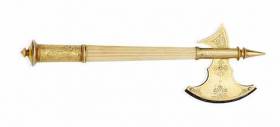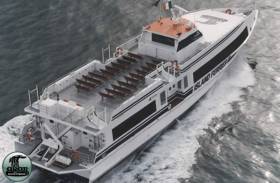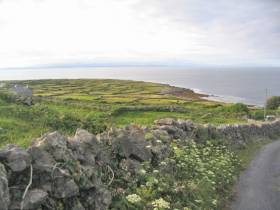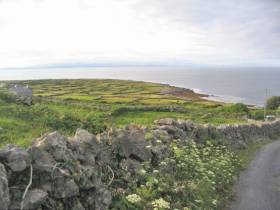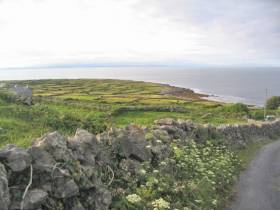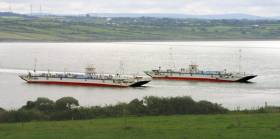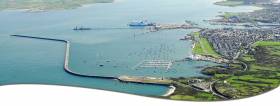Displaying items by tag: ferry
Irish Ferry S.S. Ulster Launching Axe To Be Auctioned in London
A 15 carat gold and ivory launching axe for the Irish ferry S.S. Ulster, is under the hammer on Wednesday at Bonham's Marine Auction in London. The ceremonial axe has a fluted ivory shaft, gold terminal inscribed "ULSTER" / launched at / BIRKENHEAD / 27th June 1896, it is 8in (20cm) long. The guide price is €700 - 930.
According to Bonhams, the passenger ship, Ulster, built by Laird Bros. in Birkenhead, was launched by the Duchess of Abercorn on 27th July, 1896. Registered at 2632 tons, Ulster replaced an earlier ship of the same name for the City of Dublin Steam Packet Co. She was withdrawn from service in 1920 and broken up in 1924.
More here
Stormy Irish Sea Forecast Prompts Ferry Cancellations
#IrishSea - “Averse conditions in the Irish Sea” have prompted the cancellation of six Irish Ferries sailings between Dublin and Holyhead tomorrow (Friday 23 December), as The Irish Times reports.
Passengers scheduled to travel from Dublin on the 8.45am and 10.45am ferries are advised to catch the 8.05am departure instead, while afternoon travellers are asked to make their trip later on the 8.05pm or 8.55pm sailing.
Those coming from Holyhead at 11.50am, meanwhile, will be accommodated on the next sailing some two hours later, though late afternoon travellers will have to wait till the early hours of Saturday morning (24 December).
The cancellations come as Storm Barbara sweeps in from the North Atlantic across the north of Scotland, bringing with it a high risk of stormy weather conditions in the coastal counties of Connacht and Ulster.
Inis Mór Ferry Operator Makes Deal To Halve Passenger Levy & Resume Winter Service
#AranIslands - The deadlock over Inis Mór’s winter ferry service appears to be over, after the ferry operator agreed to continue absorbing the costs of the council-imposed passenger levy.
According to Galway Bay FM, Island Ferries Teo’s proposal to reduce the levy both retroactively to 2012 and from 2017 onwards has been approved by Galway County Council.
The operator had halted services to the largest of the Aran Islands at the end of November, citing “negative fiscal conditions” that it said were a consequence of the 80c passenger levy.
It’s now emerged that half of the company’s €500,000 debt to the council will be written off, not counting upwards of €450,000 in court costs.
Sailings were restored within days on a temporary basis as talks between the company, Galway County Council and the Department of the Gaeltacht resumed earlier this month.
It’s now expected that winter sailings to and from the island will continue beyond the revised 4 January end date.
Body Recovered In Search For Woman Missing From Irish Sea Ferry
#Ferry - The body of a woman was recovered from the water in South Wales yesterday (Friday 2 December) after a major search operation for a person missing from a Pembroke-to-Rosslare ferry, as the Western Telegraph reports.
Irish Ferries’ Isle of Inishmore contacted the UK Coastguard from Rosslare shortly after 8am when the passenger was noted as missing and feared to have gone overboard, according to Sky News, prompting a major air and sea search of the Irish Sea and the Pembroke Channel at Milford Haven.
Dyfed Powys Police later confirmed the discovery of a body in the Lawrenny area east of Pembroke Dock in the upper reaches of the Western Cleddau, though it has not formally been identified.
Operator Pulls Inis Mór Winter Ferry Service
#AranIslands - Ferry services to the mainland from the largest of the Aran Islands will be suspended till March from tomorrow following a last-ditch effort to extend winter sailings.
As previously reported on Afloat.ie, Inis Mór residents were guaranteed their ferry till the end of today (Wednesday 30 November) pending a Galway County Council meeting this week to discuss a long-running dispute over passenger levies.
However, ferry operator Island Ferries Teo has now confirmed to Galway Bay FM that it will withdraw the island's winter service to from tomorrow (Thursday 1 December) till 17 March next year, citing “negative fiscal conditions”.
Aran Islands Ferry Service Extended By Fortnight
#AranIslands - Inis Mór residents have a guaranteed ferry service for two more weeks pending talks over the operator’s planned withdrawal from the island till spring.
Island Ferries Teo confirmed to Galway Bay FM that services from the Galway mainland to the largest of the Aran Islands would continue till Thursday 1 December, two weeks from today (Thursday 17 November).
That’s two days after Galway county councillors are scheduled to discuss the company’s ongoing dispute over passenger levies on 28 November.
As previously reported in Afloat.ie, the ferry operator intends to suspend its “commercially unsustainable” Inis Mór winter service till mid March next year unless the issue of levies is addressed.
Dealing Fairly With Islanders, A Part of Our Maritime Tradition
I have a great respect for those who live on our offshore islands…They are a huge part of our national culture, history and maritime tradition. To maintain island life they deserve support from all those who interact with them, both State and private. Once again, however, the Aran Islanders who live on Inish Mór are, effectively, being held to ransom in a battle between the State, the local authority in Galway and the ferry company which serves the island. Like my phraseology or not, that is the realistic assessment of the situation and I always approach such an analysis from the basis of not alone being balanced, but being fair.
The situation is highlighted in this new edition of THIS ISLAND NATION programme, by Rhoda Twombly, Secretary of Comhdháil Óileán na hÉireann, the Islands Federation.
She is, of course, addressing the situation from the point of view of the islanders when she says: “Inish Mór is facing into another Winter of uncertain ferry service. Island Ferries has stated that they will withdraw their service to the island from the 21st of November until the following 17th of March unless there is agreement between the company, the Government and Galway County Council (GCC) on levy charges at Cill Rónáin harbour. The uncertainty of ferry service has hovered over Inish Mór for the past four years and it really is time to bring a definite resolution to the matter.”
There are, I have learned in my journalistic career, not just two sides to every story, but several, depending upon the number of sides involved, but this dispute over levies in regard to improvements to the harbour at Kilronan and the paying of them as a contribution for better facilities or, on the other hand, the commitment which the State and also, perhaps, through its local authority, should make towards the physical resources of an offshore island, has been going on for far too long. It seems to have become a “hardy annual.”
I have a great respect for those who live on our offshore islands.
I hope the ferry problem to Inish Mór will be resolved.
• Listen to Listen to Rhoda Twombly on THIS ISLAND NATION Podcast below
Inis Mór Ferry Services Suspended Till Spring Over Levy Dispute
#AranIslands - “Policy decisions beyond our control” have been cited by Island Ferries Teo for its suspension of services between the mainland and the largest of the Aran Islands from November till next spring, as Galway Bay FM reports.
The move follows a long-running dispute over a council-imposed passenger levy for the non-PSO ferry route to Inis Mór that’s been subject to sharp fare increases over a number of years.
Earlier this year a deal was reached to extend ferry services to the island that were slated to end in January, after a Supreme Court ruling that forced the company to pay landing charges, according to TheJournal.ie.
However, the company now says it has reached an impasse with the Government and Galway County Council and had been left with no course of action other than to suspend the “commercially unsustainable” winter service.
TheJournal.ie has more on the story HERE.
Frequency On Shannon Shifts to Winter Schedule
#Schedule -Ireland’s longest river crossing by car ferry, operated by Shannon Ferries, have introduced a winter schedule timetable, writes Jehan Ashmore.
A winter sailing frequency on their 20 minute crossing of the estuary along the Wild Atlantic Way, between counties Clare and Kerry was introduced last weekend.
According to the operator, there will be single ferry operating with sailings from Killimer to Tarbert every hour on the hour from 7am to 7pm.
For crossings in the opposite direction, sailings from Tarbert to Killimer are every hour on the half hour from 7.30am to 7.30pm. Whereas, Sunday sailings commence two hours later.
The winter sailing continuous to 31st March, 2017, from thereon a revised schedule begins for April and May in advance of high-season traffic over the summer months.
Carrying a mix of vehicle types, including coaches and HGV’s, are a pair of UK built double-ended ro-ro half-sisters ferries. Shannon Dolphin (52 cars/350 pass) and the slightly larger Shannon Breeze, albeit in terms of a 60 vehicle capacity.
The ferries were purpose built by Appledore Shipbuilders, north Devon, during 1995 and 2000 respectively.
.
Stena Achieves Zero Landfill Target at Port of Holyhead
#Landfill - Stena Line according to Cruise News UK has announced it has achieved its zero landfill target at their Port of Holyhead in Wales.
The company been working closely with Kevin Humphrey’s Waste Recycling Ltd to reach this landmark achievement which means that all waste generated by the Port and its visiting ships has been 100% recycled with nothing being sent to landfill.
Wyn Parry, Stena Line Port Manager at Holyhead commented: “We are delighted that we have achieved our zero landfill target and have made huge progress in our commitment to caring for the environment.
“The Holyhead Port handles approximately 55 tonnes of waste per month so it is very important to us that we deal with it in a responsible way,” Wyn added.
For more on the story, click here.


























